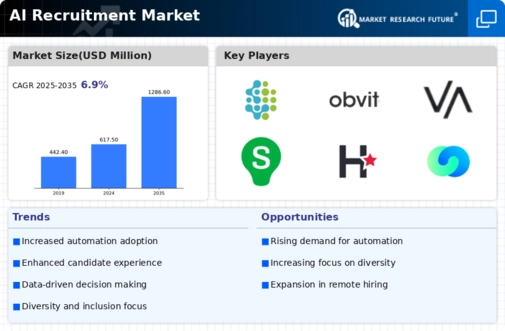Market Share
AI Recruitment Market Share Analysis
To create a niche for themselves in the cutthroat world of AI recruiting, companies use all kinds of ways to position their market shares. One practice in particular is product differentiation, with companies trying to enhance their competitive edge by adding new and interesting features. In order to win over enterprises seeking innovative answers, companies add cutting-edge features into their products. Some of the features might be strong machine learning algorithms, natural language processing capability, predictive analytics and so on.
This approach can aid the development of a reputation as technical leader and increase market share. Maintaining one's position in the AI recruiting field also involves building alliances and co-opetitions. To boost its visibility and products/services, many companies team up with other groups such as HR tech providers, trade associations or schools. These alliances allow the provision of integrated solutions with end-to-end recruiting capabilities, which in turn will bring a larger base of clients. With the skills of many partners, companies can carve out market share collaboratively and synergistically. The methods used in market share positioning are entirely customer-oriented. Those brands that attempt to learn about and satisfy the needs of customers were more likely to retain them. Either way, by providing AI recruiting solutions tailored to the different needs of various industries or enabling customers to customize features themselves, companies can help their clients reach out and connect with a wide range of consumers.
It is important to grow market share through word-of-mouth advertising and client recommendations as well, so providing excellent customer support training and postproject implementation services is essential. This whole customer experience is improved. Market penetration strategies have the aim of raising one's share by targeting as-yet unpenetrated demographic groups or geographical areas. Some businesses may attempt to win over those small and medium-sized enterprises (SMEs) with limited resources by providing budget versions of their artificial intelligence recruiting software at lower prices.
Another part of the market penetration plan could be entering new areas or markets where future needs for AI-enabled recruiting solutions are rapidly growing. In order to expand their footing in the market and better compete for its share, businesses have been fine-tuning pricing strategies along with expanding geographic scope. The most basic cost leadership positioning strategy for a market share seeks to be the lowest supplier in all of AI recruiting. With this strategy the company hopes to attract price-sensitive consumers by emphasizing operating efficiency, cutting manufacturing costs and offering competitive pricing.
















Leave a Comment